Apretude
Generic name: cabotegravir
Medically reviewed by A Ras MD. Last updated April 25, 2022
What is Apretude?
Apretude is a prescription medicine used for HIV-1 PrEP to reduce the risk of getting HIV-1 infection in adults and adolescents who weigh at least 77 pounds (at least 35 kg).
HIV-1 is the virus that causes Acquired Immune Deficiency Syndrome (AIDS).
It is not known if Apretude is safe and effective in children younger than 12 years of age or weighing less than 77 pounds (less than 35 kg).
Description
APRETUDE contains cabotegravir extended-release injectable suspension, an HIV INSTI.
The chemical name of cabotegravir is (3S,11aR)-N-[(2,4-difluorophenyl)methyl]-6-hydroxy-3-methyl-5,7-dioxo-2,3,5,7,11,11a-hexahydro[1,3]oxazolo[3,2-a]pyrido[1,2-d]pyrazine-8-carboxamide.The empirical formula is C19H17F2N3O5 and the molecular weight is 405.35 g/mol. It has the following st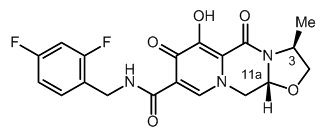
Cabotegravir extended-release injectable suspension is a white to light pink free-flowing suspension for intramuscular injection in a sterile single-dose vial. Each vial delivers 600 mg/3 mL (200 mg/mL) of cabotegravir and mannitol (105 mg), polyethylene glycol (PEG) 3350 (60 mg), polysorbate 20 (60 mg), and Water for Injection.¶
The vial stoppers are not made with natural rubber latex.
What is the most important information I should know about Apretude?
Important information for people who receive Apretude to help reduce their risk of getting human immunodeficiency virus-1 (HIV-1) infection, also called pre-exposure prophylaxis or “PrEP”:
Before receiving Apretude to reduce your risk of getting HIV-1:
- You must be HIV-1 negative to start Apretude. You must get tested to make sure that you do not already have HIV-1 infection.
- Do not receive Apretude for HIV-1 PrEP unless you are confirmed to be HIV-1 negative.
- Some HIV-1 tests can miss HIV-1 infection in a person who has recently become infected. If you have flu-like symptoms, you could have recently become infected with HIV-1. Tell your healthcare provider if you had a flu-like illness within the last month before starting Apretude or at any time while receiving Apretude. Symptoms of new HIV-1 infection include:
While you are receiving Apretude for HIV-1 PrEP:
- Apretude does not prevent other sexually transmitted infections. Practice safer sex by using a latex or polyurethane condom to reduce the risk of getting sexually transmitted infections.
- You must stay HIV-1 negative to keep receiving Apretude for HIV-1 PrEP.
- Know your HIV-1 status and the HIV-1 status of your partners.
- Ask your partners with HIV-1 if they are taking anti-HIV-1 medicines and have an undetectable viral load. An undetectable viral load is when the amount of virus in the blood is too low to be measured in a lab test. To maintain an undetectable viral load, your partners must keep taking HIV-1 medicine as prescribed. Your risk of getting HIV-1 is lower if your partners with HIV-1 are taking effective treatment.
- Get tested for HIV-1 with each Apretude injection or when your healthcare provider tells you. You should not miss any HIV-1 tests. If you become HIV-1 infected and continue receiving Apretude because you do not know you are HIV-1 infected, the HIV-1 infection may become harder to treat.
- Get tested for other sexually transmitted infections such as syphilis, chlamydia, and gonorrhea. These infections make it easier for HIV-1 to infect you.
- If you think you were exposed to HIV-1, tell your healthcare provider right away. They may want to do more tests to be sure you are still HIV-1 negative.
- Get information and support to help reduce sexual risk behaviors.
- Do not miss any injections of Apretude. Missing injections increases your risk of getting HIV-1 infection.
- If you do become HIV-1 positive, you will need to take other medicines to treat HIV-1. Apretude is not approved for treatment of HIV-1.
If you have HIV-1 and receive only Apretude, over time your HIV-1 may become harder to treat.
Who should not use Apretude?
Do not receive Apretude if you:
- already have HIV-1 infection. If you are HIV-1 positive, you will need to take other medicines to treat HIV-1. Apretude is not approved for treatment of HIV-1.
- do not know your HIV-1 infection status. You may already be HIV-1 positive. You need to take other medicines to treat HIV-1. Apretude can only help reduce your risk of getting HIV-1 infection before you are infected.
- are allergic to cabotegravir.
- are taking any of the following medicines:
- carbamazepine
- oxcarbazepine
- phenobarbital
- phenytoin
- rifampin
- rifapentine
What should I tell my healthcare provider before using Apretude?
Before receiving Apretude, tell your healthcare provider about all your medical conditions, including if you:
- have ever had a skin rash or an allergic reaction to medicines that contain cabotegravir.
- have or have had liver problems.
- have ever had mental health problems.
- are pregnant or plan to become pregnant. It is not known if Apretude will harm your unborn baby. Apretude can remain in your body for up to 12 months or longer after the last injection. Tell your healthcare provider if you become pregnant while receiving Apretude.
Pregnancy Registry. There is a pregnancy registry for women who receive Apretude during pregnancy. The purpose of this registry is to collect information about the health of you and your baby. Talk to your healthcare provider about how you can take part in this registry. - are breastfeeding or plan to breastfeed. It is not known if Apretude can pass to your baby in your breast milk. Talk with your healthcare provider about the best way to feed your baby while receiving Apretude.
Tell your healthcare provider about all the medicines you take, including prescription and over-the-counter medicines, vitamins, and herbal supplements.
Some medicines may interact with Apretude. Keep a list of your medicines and show it to your healthcare provider and pharmacist when you get a new medicine.
You can ask your healthcare provider or pharmacist for a list of medicines that interact with Apretude.
Do not start a new medicine without telling your healthcare provider. Your healthcare provider can tell you if it is safe to receive Apretude with other medicines.
How should I use Apretude?
- Apretude is initially given as an injection into the muscle of your buttock 1 time every month for the first 2 months, then as an injection 1 time every 2 months.
- Before receiving your first injection dose of Apretude, your healthcare provider may have you take 1 oral cabotegravir tablet 1 time a day for 1 month (at least 28 days). This will allow your healthcare provider to assess how well you will tolerate cabotegravir.
- Apretude is a long-acting medicine and may stay in your body for 12 months or longer after your last injection.
- Stay under the care of a healthcare provider while receiving Apretude. It is important that you receive Apretude as scheduled.
- If you miss or plan to miss a scheduled injection of Apretude by more than 7 days, call your healthcare provider right away to discuss your PrEP options.
- If you stop receiving Apretude, talk to your healthcare provider about other options to reduce the risk of getting HIV-1 infection.
- See instructions for use.
What are the possible side effects of Apretude?
Apretude may cause serious side effects including:
- Allergic reactions. Call your healthcare provider right away if you develop a rash with Apretude. Stop receiving Apretude and get medical help right away if you develop a rash with any of the following signs or symptoms:
- fever
- generally ill feeling
- tiredness
- muscle or joint aches
- trouble breathing
- blisters or sores in mouth
- blisters
- redness or swelling of the eyes
- swelling of the mouth, face, lips, or tongue
- Liver problems. Liver problems have happened in people with or without a history of liver problems or other risk factors. Your healthcare provider may do blood tests to check your liver function.
Call your healthcare provider right away if you develop any of the following signs or symptoms of liver problems: - Depression or mood changes. Call your healthcare provider or get emergency medical help right away if you have any of the following symptoms:
- feeling sad or hopeless
- feeling anxious or restless
- have thoughts of hurting yourself (suicide) or have tried to hurt yourself
The most common side effects of Apretude include:
- pain, tenderness, hardened mass or lump, swelling, bruising, redness, itching, warmth, loss of sensation at the injection site, abscess, and discoloration
- diarrhea
- headache
- fever
- tiredness
- sleep problems
- nausea
- dizziness
- passing gas
- stomach pain
- vomiting
- muscle pain
- rash
- loss of appetite
- drowsiness
- back pain
- upper respiratory infection
These are not all the possible side effects of Apretude.
Call your doctor for medical advice about side effects. You may report side effects to FDA at 1‑800‑FDA‑1088.
General information about the safe and effective use of Apretude
Medicines are sometimes prescribed for purposes other than those listed in a Patient Information leaflet. You can ask your healthcare provider or pharmacist for information about Apretude that is written for health professionals.
How should I store Apretude?
Store at 2°C to 25°C (36°F to 77°F). Exposure up to 30°C (86°F) permitted.
Do not freeze.
Prior to administration:
- If the pack has been stored in the refrigerator, the vial should be brought to room temperature prior to administration (not to exceed 30°C [86°F]).
- Once Apretude has been drawn into the syringe, the medication can remain in the syringe for up to 2 hours before injecting. The filled syringes should not be placed in the refrigerator. If the medicine remains in the syringe for more than 2 hours, the filled syringe and needle must be discarded.
What are the ingredients in Apretude?
Active ingredient: cabotegravir
Inactive ingredients: mannitol, polyethylene glycol (PEG) 3350, polysorbate 20, and Water for Injection.
For more information, go to www.apretude.com or call 1-877-844-8872.
Instructions for use for Apretude
Apretude
(cabotegravir extended-release injectable suspension)
600 mg/3 mL
(200 mg/mL)
For gluteal intramuscular use only.
600 mg/3 mL kit
Overview:
A complete dose of Apretude requires 1 injection: 600 mg (3 mL) of cabotegravir.
Apretude is a suspension that does not need further dilution or reconstitution.
Apretude is for gluteal intramuscular use only.
Note: The ventrogluteal site is recommended.
Storage information
Store at 2°C to 25°C (36°F to 77°F). Exposure up to 30°C (86°F) is permitted.
Do not freeze.
Prior to administration:
- If the pack has been stored in the refrigerator, the vial should be brought to room temperature prior to administration (not to exceed 30°C [86°F]).
- Once Apretude has been drawn into the syringe, the medication can remain in the syringe for up to 2 hours before injecting. The filled syringes should not be placed in the refrigerator. If the medicine remains in the syringe for more than 2 hours, the filled syringe and needle must be discarded.
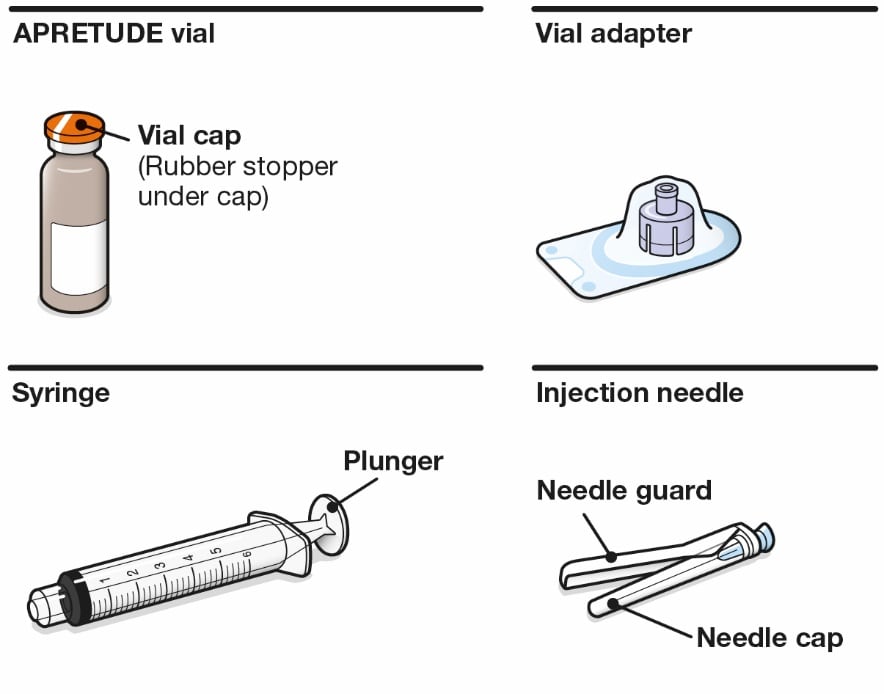
Your pack contains:
- 1 vial of Apretude
- 1 vial adapter
- 1 syringe
- 1 injection needle (23 gauge, 1½ inch)
- Consider the individual’s build and use medical judgment to select an appropriate injection needle length.
You will also need:
- Non-sterile gloves
- 2 alcohol wipes
- 2 gauze pads
- A suitable sharps container
Preparation:
1. Inspect the vial.
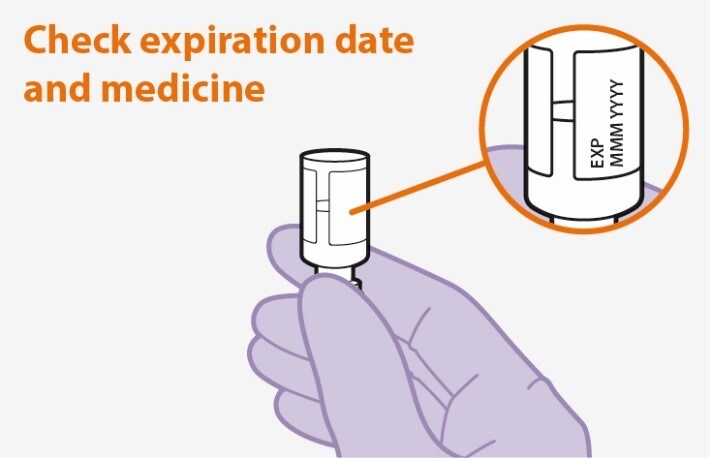
Figure A
- Check that the expiration date has not passed. See Figure A.
- Inspect the vial immediately. If you can see foreign matter, do not use the product.
Note: The vial has a brown tint to the glass.
Do not use if the expiration date has passed. - If the pack has been stored in the refrigerator, allow the medication to come to room temperature.
2. Shake the vial vigorously.
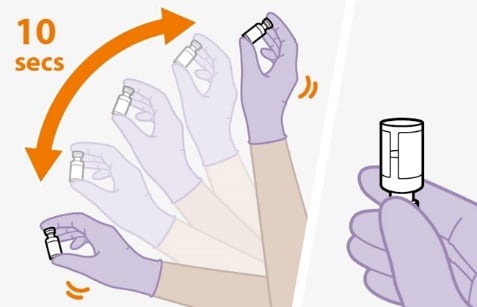
Figure B
- Hold the vial firmly, and vigorously shake for a full 10 seconds. See Figure B.
- Invert the vial and confirm the suspension is uniform. It should look uniform.
- If the suspension is not uniform, shake the vial again.
- It is also normal to see small air bubbles.
3. Remove the vial cap.
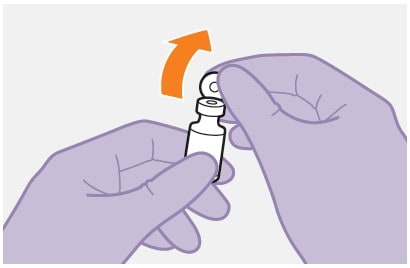
Figure C
- Remove the cap from the vial. See Figure C.
- Wipe the rubber stopper with an alcohol wipe.
- Do not allow anything to touch the rubber stopper after wiping it.
4. Peel open the vial adapter.
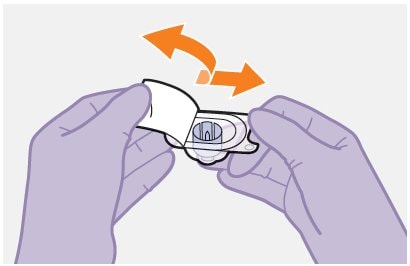
Figure D
- Peel off the paper backing from the vial adapter packaging. See Figure D.
Note: Keep the adapter in place in its packaging for the next step.
5. Attach the vial adapter.
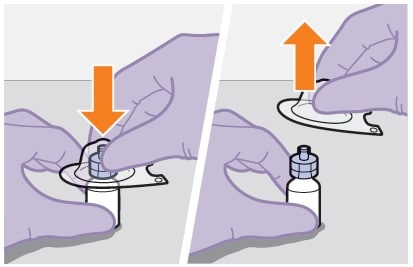
Figure E
- Press the vial adapter straight down onto the vial using the packaging, as shown. The vial adapter should snap securely into place.
- When you are ready, lift off the vial adapter packaging as shown. See Figure E.
6. Prepare the syringe.
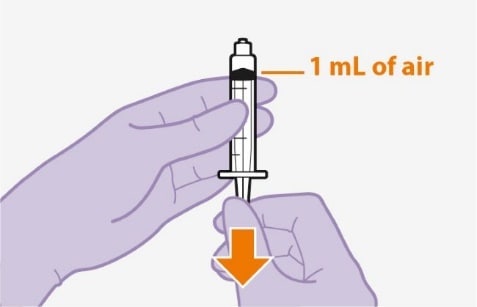
Figure F
- Remove the syringe from its packaging.
- Draw 1 mL of air into the syringe. This will make it easier to draw up the medicine later. See Figure F.
7. Attach the syringe.
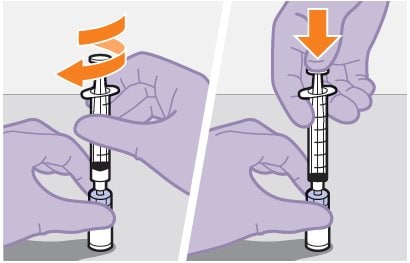
Figure G
- Hold the vial adapter and vial firmly, as shown.
- Screw the syringe firmly onto the vial adapter.
- Press the plunger all the way down to push the air into the vial. See Figure G.
8. Slowly draw up the dose.
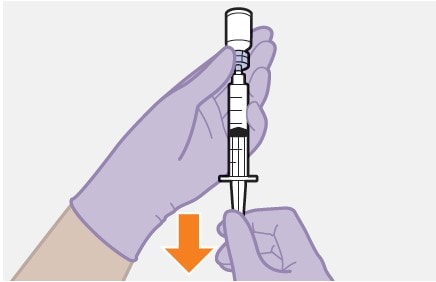
Figure H
- Invert the syringe and vial and slowly withdraw as much of the medicine as possible into the syringe. There may be more medicine than the dose amount. See Figure H.
9. Unscrew the syringe.
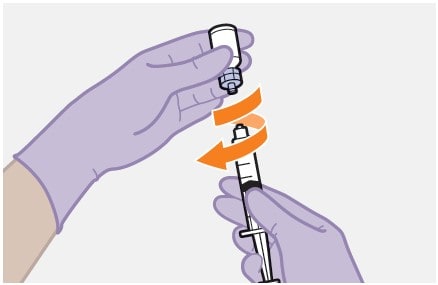
Figure I
- Unscrew the syringe from the vial adapter, holding the vial adapter as shown. See Figure I.
Note: Keep the syringe upright to avoid leakage. Check that the suspension looks uniform and milky white.
10. Attach the needle.
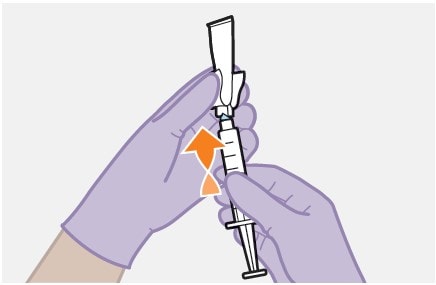
Figure J
- Peel open the needle packaging part way to expose the needle base.
- Keeping the syringe upright, firmly twist the syringe onto the needle.
- Remove the needle packaging from the needle. See Figure J.
Injection:
11. Prepare the injection site.
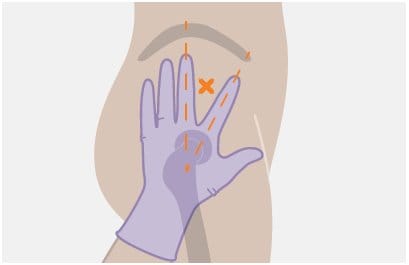
Figure K
- Apretude must be administered to a gluteal site. See Figure K.
Select from the following areas for the injection:- Ventrogluteal, as shown (recommended)
- Dorsogluteal, not shown (upper outer quadrant)Note: For gluteal intramuscular use only.
Do not inject intravenously.
12. Remove the cap.
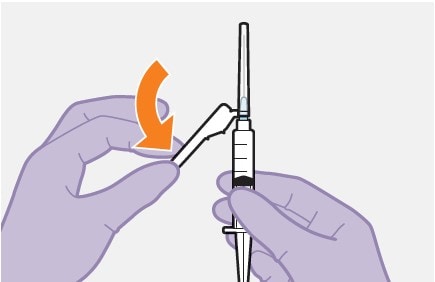
Figure L
- Fold the needle guard away from the needle. See Figure L.
- Pull off the injection needle cap.
13. Remove extra liquid from the syringe.
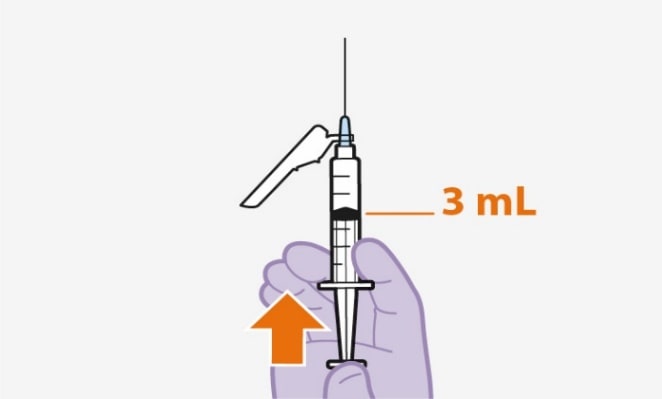
Figure M
- Hold the syringe with the needle pointing up. Press the plunger to the 3-mL dosing mark to remove extra liquid and any air bubbles. See Figure M.
Note: Clean the injection site with an alcohol wipe. Allow the skin to air dry before continuing.
14. Stretch the skin.
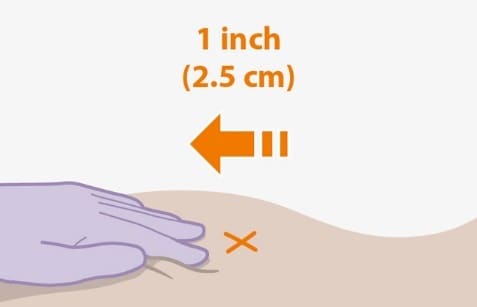
Figure N
- Use the z-track injection technique to minimize medicine leakage from the injection site.
- Firmly drag the skin covering the injection site, displacing it by about an inch (2.5 cm). See Figure N.
- Keep it held in this position for the injection.
15. Insert the needle.
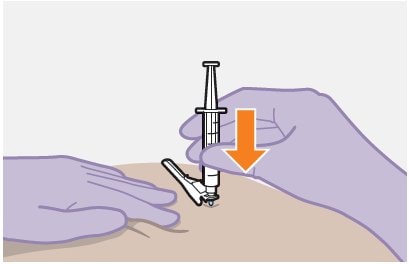
Figure O
- Insert the needle to its full depth, or deep enough to reach the muscle. See Figure O.
16. Inject the dose of medicine.
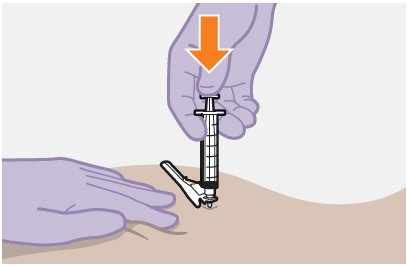
Figure P
- Still holding the skin stretched – slowly press the plunger all the way down. See Figure P.
- Ensure the syringe is empty.
- Withdraw the needle and release the stretched skin immediately.
17. Assess the injection site.
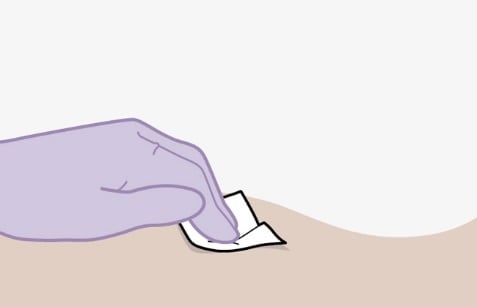
Figure Q
- Apply pressure to the injection site using a gauze pad. See Figure Q.
- A small bandage may be used if bleeding occurs.
Do not massage the area.
18. Make the needle safe.
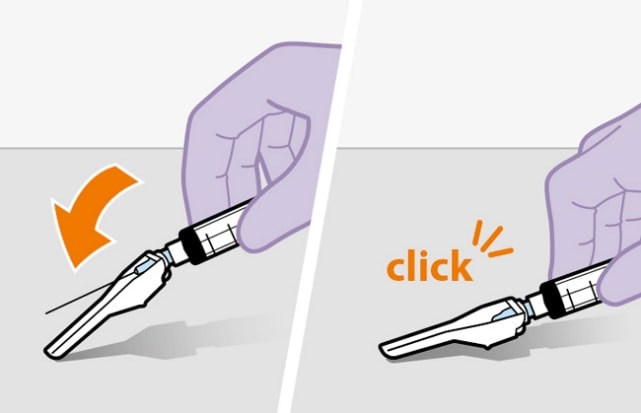
Figure R
- Fold the needle guard over the needle.
- Gently apply pressure using a hard surface to lock the needle guard in place.
- The needle guard will make a click when it locks. See Figure R.
After injection:
19. Dispose safely.
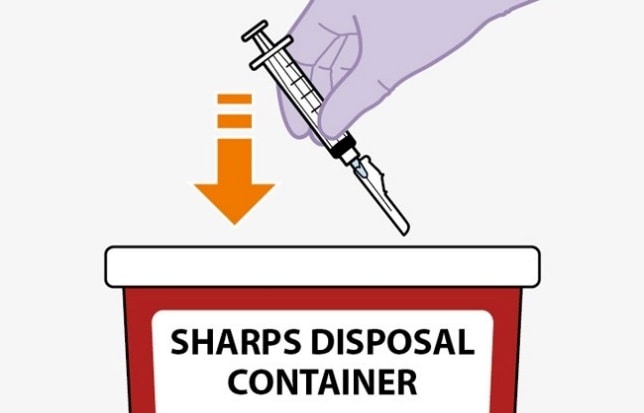
Figure S
- Dispose of used needle, syringe, vial, and vial adapter according to local health and safety laws. See Figure S.
Principal Display Panel
- NDC 49702-264-23
- Apretude
- (cabotegravir extended-release injectable suspension)
- 600 mg/3 mL
- (200 mg/mL)
- Rx Only
- For gluteal intramuscular use only.
- Healthcare Professional Administration Only.
- Contents:
- 1 Single-dose vial
- 1 Vial adapter
- 1 Syringe
- 1 Injection needle (23 gauge, 1 ½ inch)
- Prescribing Information
- Patient Information
- Instructions for Use
- ViiV Healthcare
- 600 mg/ 3 mL Kit
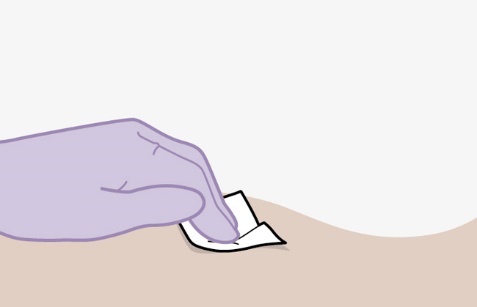
Source:NLM
